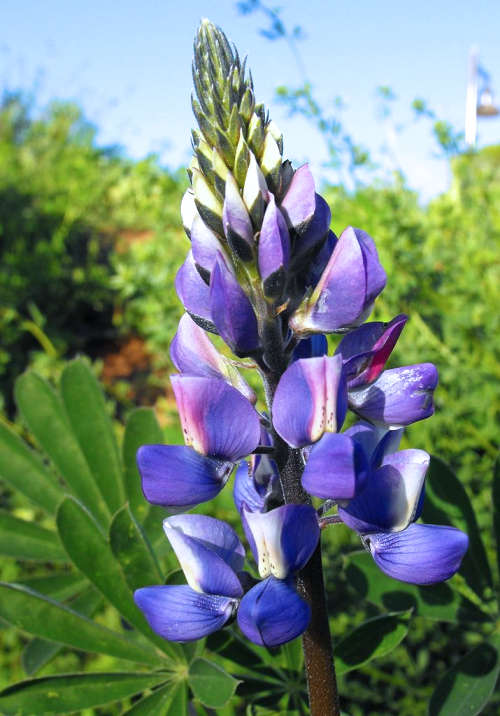Description
Form:
Herb.
Lifespan:
Annual.
Growth rate:
Rapid.
Mature Size:
1-4' (0.3-1.2m) high and up to 3' (1m) wide. The size depends on the amount of water
received.
Flowers:
Blue, purple or white, with possible patches of red or yellow on the banner (top) petal,
pea-shaped, 5 petals, slight fragrance, clustered in whorls on a stalk.
Pollinated flowers may slightly change hue from bluish to pinkish.
Bloom:
Mid winter to late spring depending on cultivar and location. Deadheading the spent
flowers can cause repeat blooming well into summer.
Fruit:
A hairy legume pod 3/8" (1cm) wide and 2" (5cm) long containing approximately 12 seeds.
When a pod matures to brown and dry, it snaps open abruptly with a twist, throwing seeds in
all directions.
Leaves:
Green, 7-9 leaflets radiating from a single point (palmate), smooth to slightly hairy on top.
Stems:
Green, fleshy, thick, with many branches.
Roots:
A 3' (1m) deep taproot supports an extensively branched fibrous root system that is somewhat
fragile and does not transplant easily.
Like all legumes, the roots of this plant are nitrogen-fixing.*
Wildlife:
The flowers attract bees and a large number of butterfly and moth species. The leaves and
stems host their caterpillars.
The seeds scattered on the ground attract quail and other seed eating birds.
Some species of large red ants are known to eat the roots of the plant.
Toxic / Danger:
All parts of the plant contain alkaloids that are poisonous to humans and animals.
Origin:
California and adjacent parts of Arizona and Baja California, Mexico.
Cultivation and Uses
USDA hardiness zones:
7-10. These seedlings do not tolerate frost.
Heat tolerant:
Partly. The plant is stressed above 95°F (35°C). Above 106°F (41°C), the
leaves become susceptible to sunburn and curling; parts of the plant may wilt and die.
This plant is more heat tolerant than many Lupinus species.
Drought tolerant:
After the first month of growth, it can tolerate less water, but that will affect plant size
and flowering. Drought will also cause early seedpod production, resulting in fewer flowers
and a shorter lifespan.
Sun:
This plant needs no more than 8-10 hours of sunlight and must have afternoon shade in hot
climates.
Planting:
Place the seeds directly in the ground in their desired location as soon as daily temperatures
reach 55-70°F (13-21°C). See Propagation, below.
Select a location where the soil is well draining and receives full morning sun and afternoon
shade.
If temperatures are expected to be over 105°F (41°C) the plant must be shaded from
midday on.
Soil:
This plant grows in many soil types as long as they are well draining, with a range of
pH 6.1-7.8 (slightly acidic to slightly alkaline). It tolerates soil poor in nutrients but
struggles in chalky soil.
Organic fertilizer may be used, but *do not use a nitrogen-containing chemical fertilizer.
Water:
Keep the soil slightly moist until the seedlings are well established, then back off to
weekly watering, taking rainfall into account.
Watering less often may degrade appearance.
In the hottest part of summer, watering twice a week may be necessary to avoid wilting.
Over watering can lead to root crown rot.
Underwatering will cause the plant to produce seedpods more quickly and shorten flower
duration.
Mulch:
One inch (2.5cm) of organic mulch can be used to reduce soil heating and drying, but keep it
6" (15cm) away from the stem to avoid root crown rot.
Prune:
Trim away sunburned and dried-up parts during the summer.
Cut off spent flowers before seedpods form to encourage repeat blooming.
Litter:
The entire plant dies once all seedpods have released their seeds.
Propagation:
Soak seeds in hydrogen peroxide (3%) for 5 minutes, then in hot water for 6-8 hours.
Sow directly in the ground 1/8"-1/4" (0.3cm-0.6cm) deep. Germination rate varies from
20-98%. Unlike most lupines, the seed of this particular species does not need cold
stratification.
Pests:
Rabbits and mice are known to nibble the seed pods and other plant parts. Birds may tear off
immature seedpods.
Uses:
Ornamental, erosion control, bank stabilization. Lupines are often used in crop rotation to
improve soil because their roots are nitrogen fixing and have the ability to break up hard
soil. They are sometimes plowed under at the end of the season to act as a green manure.
Comments
This plant is a member of the Legume family (Fabaceae).
Another common name for this plant is Hollowleaf Annual Lupine.
This plant is related to Lupinus mutabilis (Andean Lupin), and Lupinus angustifolius
(Narrow-leaf Lupin). Both are cool-summer plants having low alkaloid cultivars grown for
their edible beans.
The origin of the name Lupinus for this genus of plants is in dispute. The most common
explanation is obviously wrong: that the word, which means "wolf" in Latin, suggests that
it ravenously exhausts the soil. Based on the writings of the ancient Roman historian Pliny
the Elder, who introduced the name, and who knew that the plant enriches soil, it may refer
to the swaying of Lupine plants in a meadow appearing similar to a wolf tail.
Another reasonable explanation is that the name refers to the plant poisons attacking
plant-eating animals that wolves also attack.
Do you have additional information or a different experience for this plant that you would
like to share? Email info@GardenOracle.com. All contributions are welcome and appreciated.

